Improved Numerical Modeling of Terahertz Wave Propagation in Epoxy Coating with the Finite-Difference Time-Domain Method
Abstract
:1. Introduction
2. FDTD Model of Terahertz Non-Destructive Testing of Coating Structure
2.1. FDTD Alrightm
2.2. Coating Parameter Setting
2.3. Simulation Parameter Setting
3. Results
3.1. Simulation of Epoxy Coating Aging
3.2. Simulation of Epoxy Coating with Rusted Defect
4. Conclusions
Author Contributions
Funding
Institutional Review Board Statement
Informed Consent Statement
Data Availability Statement
Conflicts of Interest
References
- Ellrich, F.; Bauer, M.; Schreiner, N.; Keil, A.; Pfeiffer, T.; Klier, J.; Weber, S.; Jonuscheit, J.; Friederich, F.; Molter, D. Terahertz quality inspection for automotive and aviation industries. J. Infrared Millim. Terahertz Waves 2020, 41, 470–489. [Google Scholar] [CrossRef]
- Fuse, N.; Fukuchi, T.; Mizuno, M.; Fukunaga, K. High-speed underfilm corrosion imaging using a terahertz camera. Electr. Commun. Jpn. 2016, 99, 86–92. [Google Scholar] [CrossRef]
- Roqueta, G.; Jofre, L.; Feng, M.Q. Analysis of the electromagnetic signature of reinforced concrete structures for nondestructive evaluation of corrosion damage. IEEE T. Instrum. Meas. 2012, 61, 1090–1098. [Google Scholar] [CrossRef]
- Rana, S.; Rakin, A.S.; Hasan, M.R.; Reza, M.S.; Leonhardt, R.; Abbott, D.; Subbaraman, H. Low loss and flat dispersion Kagome photonic crystal fiber in the terahertz regime. Opt. Commun. 2018, 410, 452–456. [Google Scholar] [CrossRef]
- Serebryannikov, A.E.; Alici, K.B.; Ozbay, E.; Lakhtakia, A. Thermally sensitive scattering of terahertz waves by coated cylinders for tunable invisibility and masking. Opt. Express 2018, 26, 1–14. [Google Scholar] [CrossRef] [PubMed]
- Lopato, P.; Chady, T.; Sikora, R.; Gratkowski, S.; Ziolkowski, M. Full wave numerical modelling of terahertz systems for nondestructive evaluation of dielectric structures. COMPEL-Int. J. Comput. Math. Electr. Electron. Eng. 2013, 32, 736–749. [Google Scholar] [CrossRef]
- Zhou, T.Y.; Li, L.J.; Ren, J.J.; Zhang, D.D.; Zhang, J.Y. Pulsed terahertz nondestructive testing of glass fiber reinforced plastics based on FDTD. Acta Opt. Sin. 2020, 40, 1226002. (In Chinese) [Google Scholar] [CrossRef]
- Zhu, L.L.; Ren, J.J.; Zhang, D.D.; Li, L.J. Analysis of debonding defects of GFRP in terahertz nondestructive testing based on FDTD. In Proceedings of the 2021 46th International Conference on Infrared, Millimeter and Terahertz Waves (IRMMW-THz), Chengdu, China, 29 August–3 September 2021; p. 9566879. [Google Scholar] [CrossRef]
- Xu, Z.; Ye, D.D.; Chen, J.; Zhou, H.T. Novel terahertz nondestructive method for measuring the thickness of thin oxide scale using different hybrid machine kearning models. Coatings 2020, 10, 805. [Google Scholar] [CrossRef]
- Ye, D.D.; Wang, W.Z.; Yin, C.D.; Xu, Z.; Zhou, H.T.; Fang, H.J.; Li, Y.J.; Huang, J.B. Pulsed terahertz spectroscopy combined with hybrid machine learning approaches for structural health monitoring of multilayer thermal barrier coatings. Opt. Express 2020, 28, 34875–34893. [Google Scholar] [CrossRef]
- Cao, B.H.; Cai, E.; Fan, M.B. NDE of discontinuities in thermal barrier coatings with terahertz time-domain spectroscopy and machine learning classifiers. Mater. Eval. 2021, 79, 125–135. [Google Scholar] [CrossRef]
- Jiang, X.L.; Xu, Y.; Zhao, D.C. Terahertz Non-destructive testing and imaging of corrosion in coated steel plates. Constr. Build. Mater. 2023, 385, 131427. [Google Scholar] [CrossRef]
- Tu, W.L.; Zhong, S.C.; Shen, Y.C.; Incecik, A.; Fu, X.B. Neural network-based hybrid signal processing approach for resolving thin marine protective coating by terahertz pulsed imaging. Ocean Eng. 2019, 173, 58–67. [Google Scholar] [CrossRef]
- Tu, W.L.; Zhong, S.C.; Shen, Y.C.; Incecik, A. Nondestructive testing of marine protective coatings using terahertz waves with stationary wavelet transform. Ocean Eng. 2016, 111, 582–592. [Google Scholar] [CrossRef]
- Sullivan, D.M. Electromagnetic Simulation Using FDTD Method; IEEE Microwave Theory Society: Piscataway, NJ, USA, 2013; pp. 67–99. [Google Scholar]
- Taflove, A.; Umashankar, K.R. The finite-difference time-domain method for numerical modeling of electromagnetic wave interactions. Electromagnetics 1990, 10, 105–126. [Google Scholar] [CrossRef]
- Hu, S.; Liu, L.; Gao, T.C.; Zhang, T.; Chen, M. A scattering simulation model for nonspherical aerosol particles based on parallel FDTD scheme. Int. Arch. Photogramm. Remote Sens. Spat. Inf. Sci. 2019, 42, 71–76. [Google Scholar] [CrossRef]
- Barden, P.; Sosiak, C.E.; Grajales, J.; Hawkins, J.; Rizzo, L.; Clark, A.; Gatley, S.; Gatley, I.; Federici, J. Non-destructive comparative evaluation of fossil amber using terahertz time-domain spectroscopy. PLoS ONE 2022, 17, e0262983. [Google Scholar] [CrossRef] [PubMed]
- Roggero, A.; Caussé, N.; Dantras, E.; Villareal, L.; Santos, A.; Pebere, N. Thermal activation of impedance measurements on an epoxy coating for the corrosion protection: 1. dielectric spectroscopy response in the dry state. Electrochim. Acta 2019, 303, 239–245. [Google Scholar] [CrossRef]
- Macutkevic, J.; Seliuta, D.; Valusis, G.; Adomavicius, R.; Kuzhir, P.; Paddubskaya, A.; Shuba, M.; Maksimenko, S.; Coderoni, L.; Micciulla, F.; et al. Terahertz time domain spectroscopy of epoxy resin composite with various carbon inclusions. Chem. Phys. 2012, 404, 129–135. [Google Scholar] [CrossRef]
- Kusano, M.; Kubouchi, M.; Bulgarevich, D.S.; Shiwa, M. Non-destructive evaluation by terahertz spectroscopy for penetration of acid solutions into epoxy resin. Express Polym. Lett. 2016, 10, 941–949. [Google Scholar] [CrossRef]
- Miao, Q.; Zhao, K.; Tian, L.; Zhao, G.Z.; Liu, L.M. Research on spectroscopy of epoxy resin and its mixture in terahertz range. Mod. Sci. Instrum. 2011, 6, 31–33. (In Chinese) [Google Scholar]
- Zhang, J.; Cui, H.L.; Shi, C.C.; Chen, J.D.; Zhang, Z.Y.; Han, X.H. Terahertz spectroscopic study on the property of epoxy resin adhesive. Spectrosc. Spectr. Anal. 2016, 36, 919–932. (In Chinese) [Google Scholar]
- Cheng, B.; Ren, J.; Gu, J.; Li, L.; Gao, T. High-precision thickness detection of coatings based on terahertz propagation simulation model. Acta Opt. Sinica. 2020, 40, 80–86. (In Chinese) [Google Scholar]
- Rutz, F.; Koch, M.; Khare, S.; Moneke, M.; Richter, H.; Ewert, U. Terahertz quality control of polymeric products. Int. J. Infrared Millim. Waves 2006, 27, 547–556. [Google Scholar] [CrossRef]
- Tu, W.L.; Zhong, S.C.; Luo, M.T.; Zhang, Q. Non-destructive evaluation of hidden defects beneath the multilayer organic protective coatings Based on terahertz technology. Front. Phys. 2021, 9, 676851. [Google Scholar] [CrossRef]
- Ma, H.B.; Tang, C.; Tang, A.B.; Ma, Q.K.; Yang, B.; Wang, G. Study on dielectric constant and dielectric loss factor of epoxy resin _DDS curing agent system. Transformer 2007, 44, 41–42. (In Chinese) [Google Scholar]
- Yakovlev, E.V.; Zaytsev, K.I.; Dolganova, I.N.; Yurchenko, S.O. Non-destructive evaluation of polymer composite materials at the manufacturing stage using terahertz pulsed spectroscopy. IEEE Trans. Terahertz Sci. Technol. 2015, 5, 810–816. [Google Scholar] [CrossRef]
- Prevosto, D.; Bartolini, P.; Torre, R.; Ricci, M.; Taschin, A.; Capaccioli, S.; Lucchesi, M.; Rolla, P. Relaxation processes in an epoxy resin studied by time-resolved optical kerr effect. Phys. Rev. E Stat. Nonlinear Soft Matter Phys. 2002, 66, 011502. [Google Scholar] [CrossRef]
- Wang, J.; Wang, Z.; Liu, R.Y.; Xiao, R.F.; Li, Q.M. Study on adhesion reliability and particle inhibition of epoxy resin coating in DC GIL after thermal ageing experiment. Coatings 2022, 12, 858. [Google Scholar] [CrossRef]
- Fuse, N.; Fukuchi, T.; Takahashi, T.; Mizuno, M.; Fukunaga, K. Evaluation of applicability of noncontact analysis methods to detect rust regions in coated steel plates. IEEE Trans. Terahertz Sci. Technol. 2012, 2, 242–249. [Google Scholar] [CrossRef]
- Wu, R.K.; Zhang, H.; Yang, R.Z.; Chen, W.H.; Chen, G.T. Nondestructive testing for corrosion evaluation of metal under coating. J. Sens. 2021, 2021, 6640406. [Google Scholar] [CrossRef]
- Cheng, Y.; Hanif, A.; Chen, E.; Ma, G.C.; Li, Z.J. Simulation of a novel capacitive sensor for rebar corrosion detection. Constr. Build. Mater. 2018, 174, 613–624. [Google Scholar] [CrossRef]
- Madhavi, T.C.; Annamalai, S. Electrical conductivity of concrete. ARPN J. Eng. Appl. Sci. 2016, 11, 5980–5982. [Google Scholar]
- He, Y.Z.; Tian, G.Y.; Zhang, H.; Alamin, M.; Simm, A.; Jackson, P. Steel corrosion characterization using pulsed eddy current systems. IEEE Sens. J. 2012, 12, 2113–2119. [Google Scholar] [CrossRef]

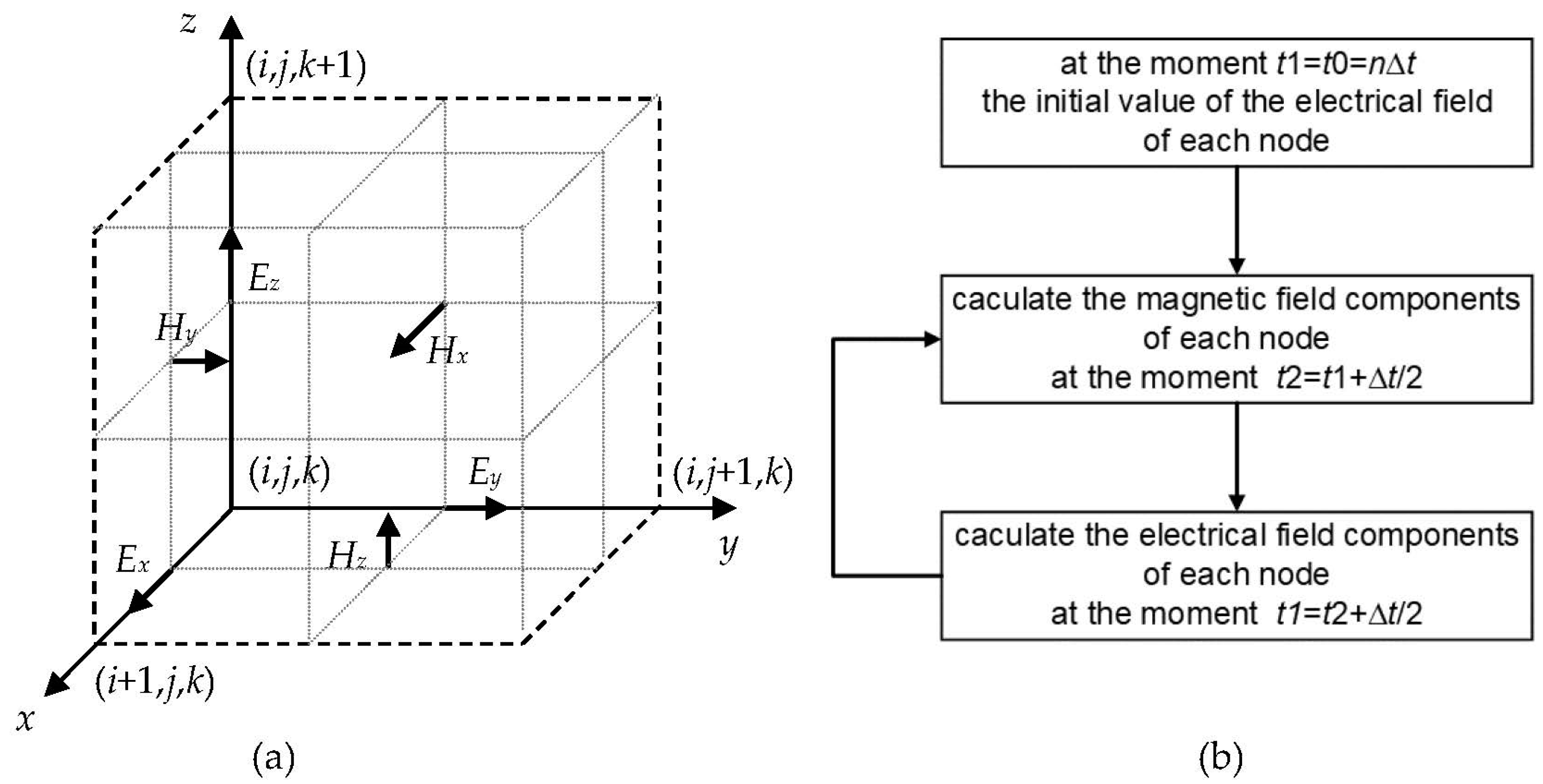

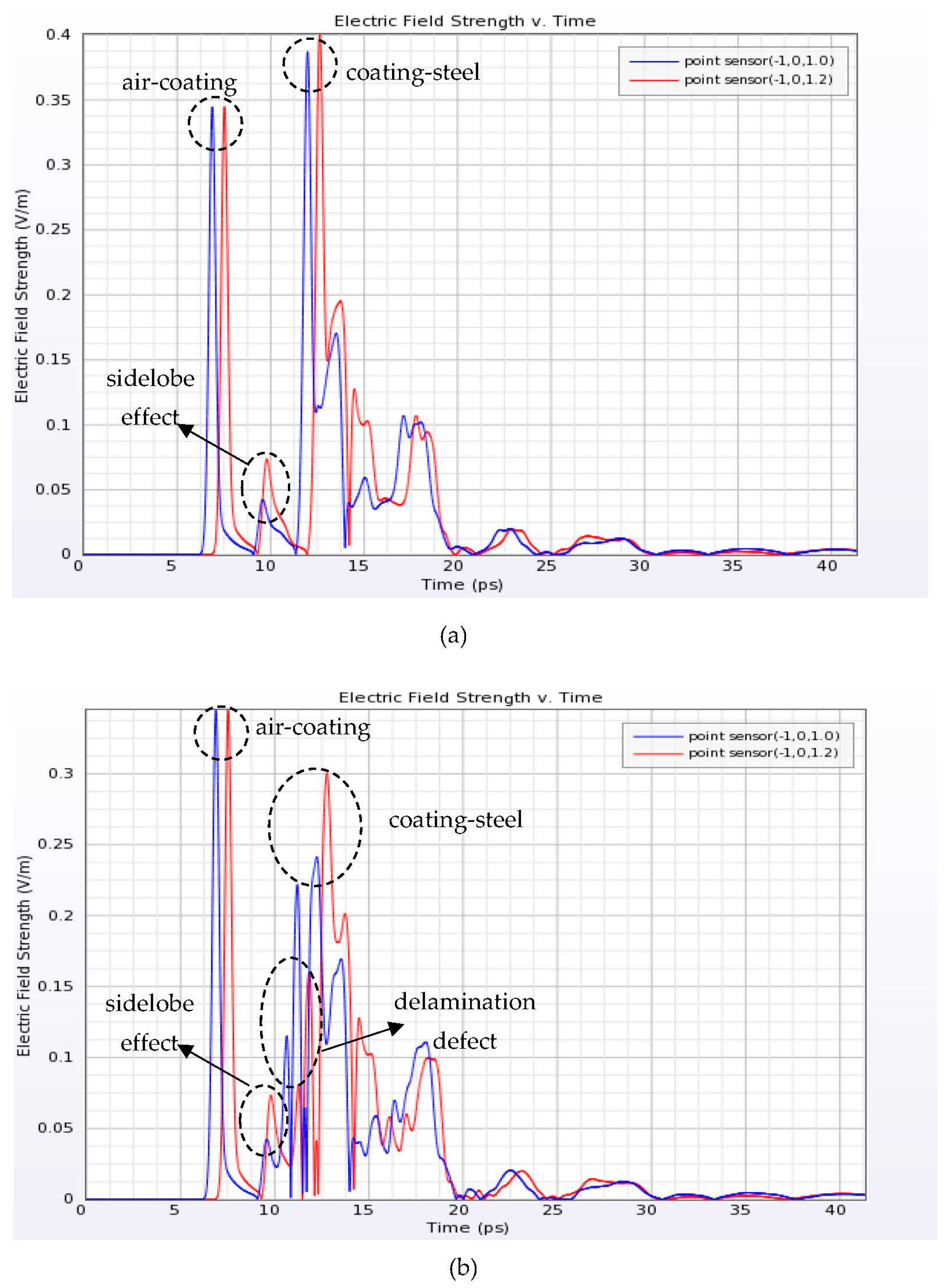
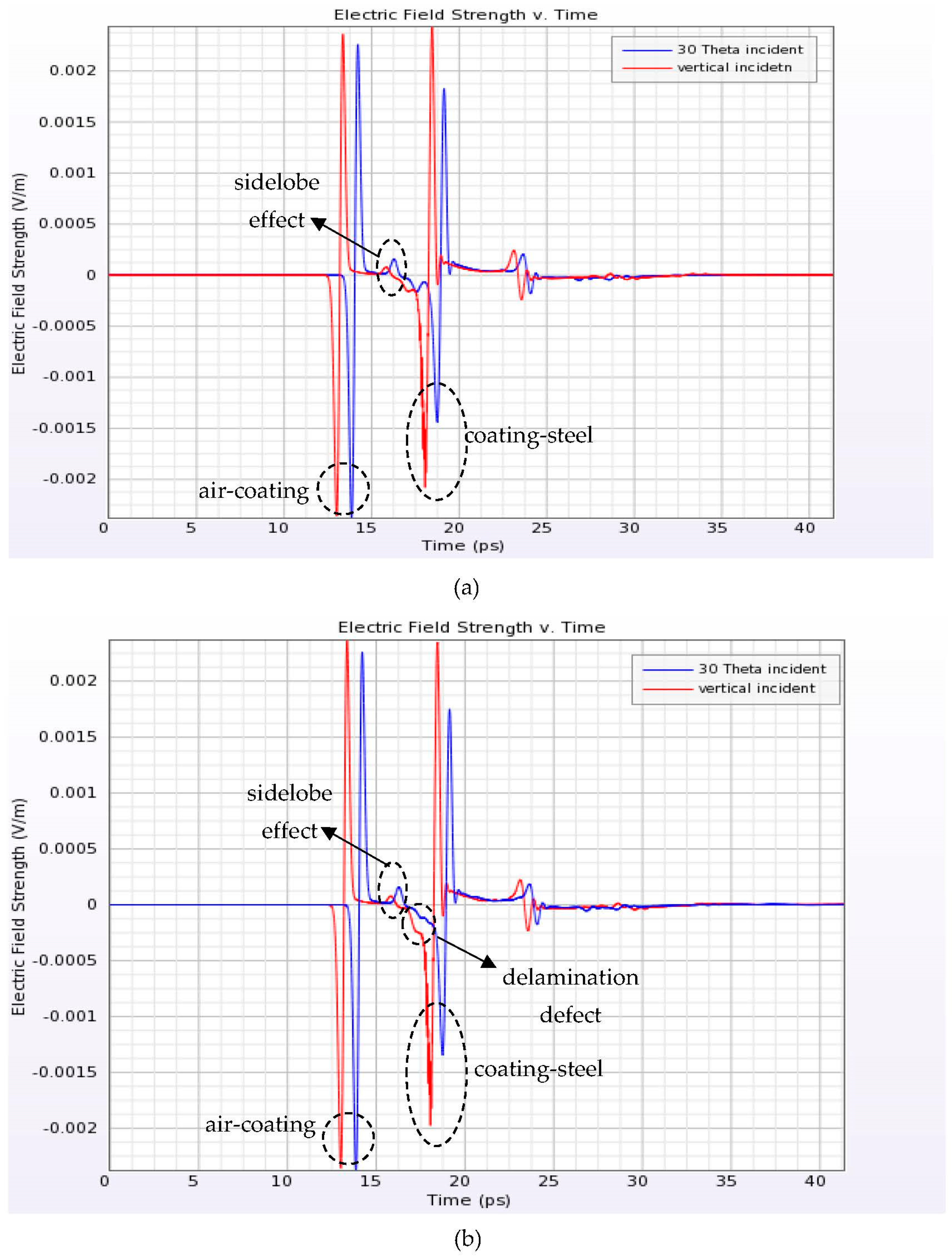
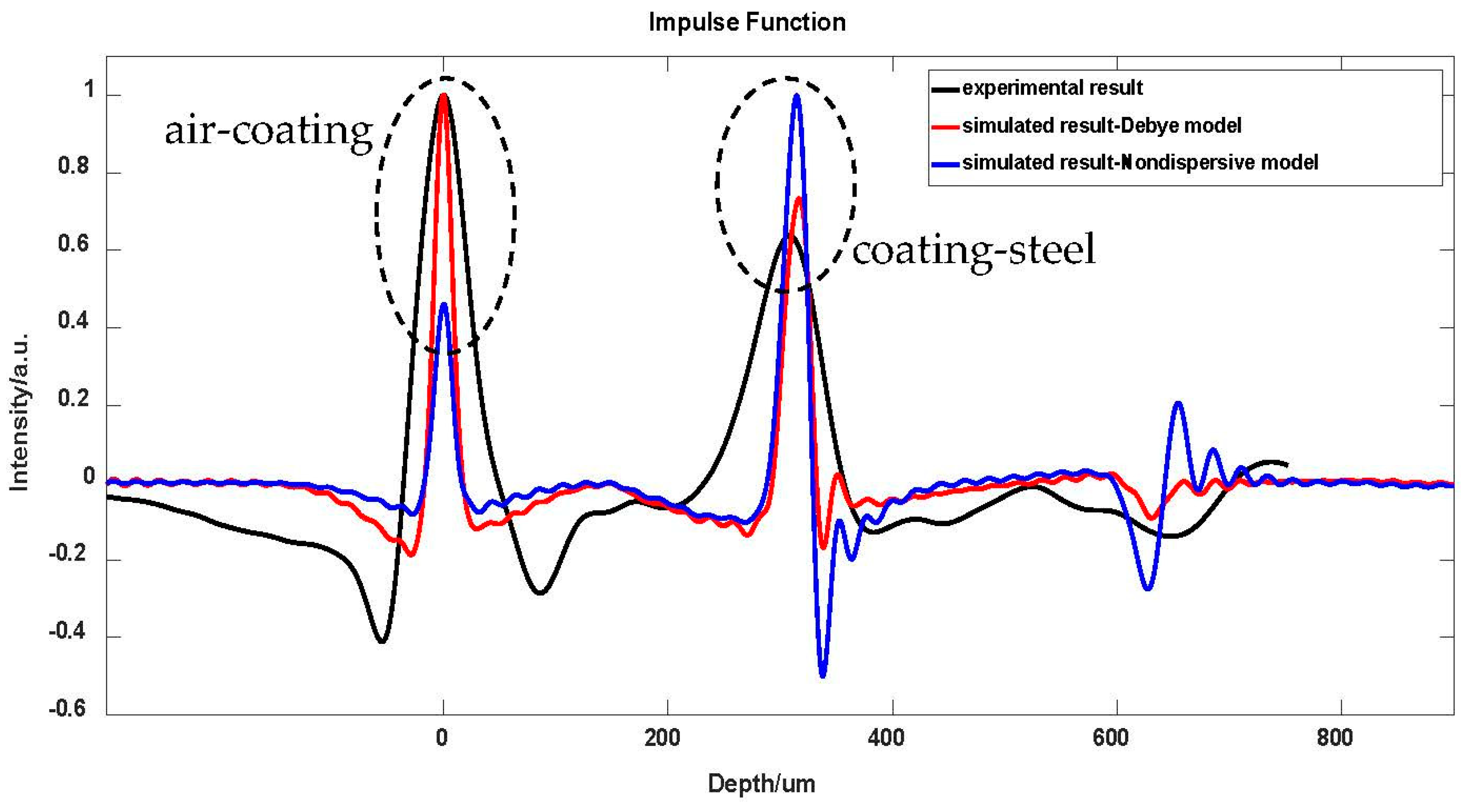
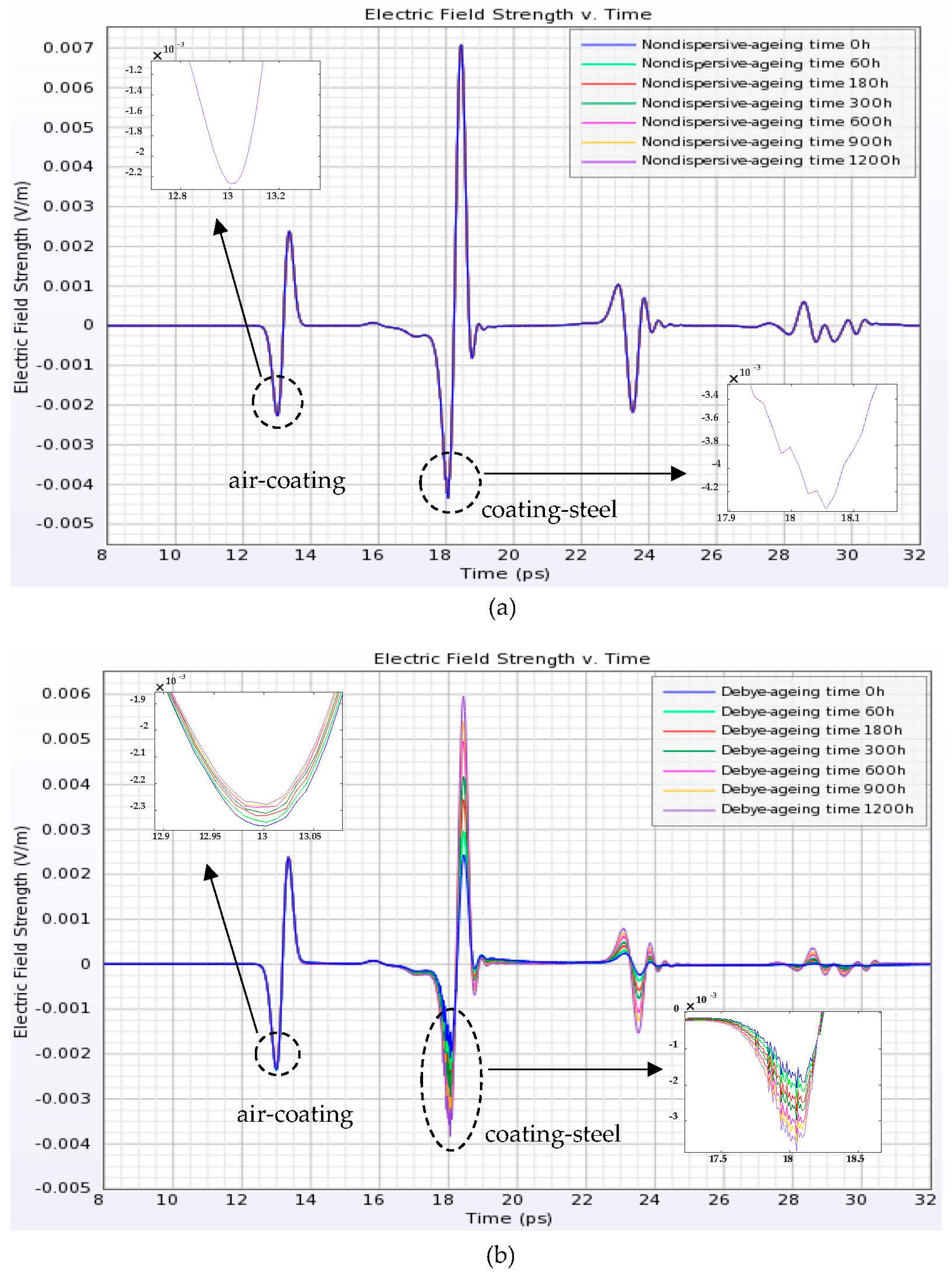
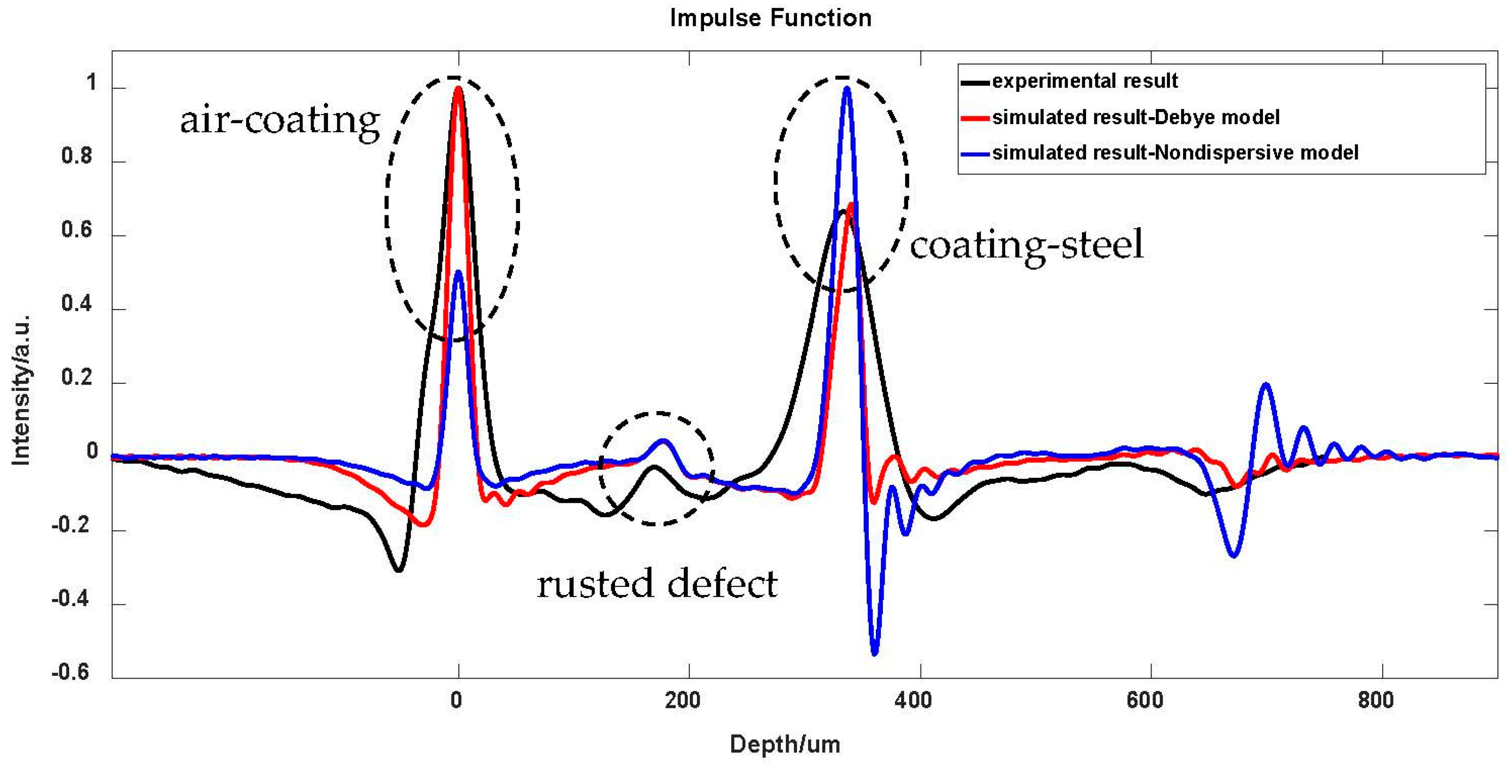

Disclaimer/Publisher’s Note: The statements, opinions and data contained in all publications are solely those of the individual author(s) and contributor(s) and not of MDPI and/or the editor(s). MDPI and/or the editor(s) disclaim responsibility for any injury to people or property resulting from any ideas, methods, instructions or products referred to in the content. |
© 2023 by the authors. Licensee MDPI, Basel, Switzerland. This article is an open access article distributed under the terms and conditions of the Creative Commons Attribution (CC BY) license (https://creativecommons.org/licenses/by/4.0/).
Share and Cite
Tu, W.; Zhong, S.; Zhang, Q.; Huang, Y.; Luo, M. Improved Numerical Modeling of Terahertz Wave Propagation in Epoxy Coating with the Finite-Difference Time-Domain Method. Coatings 2023, 13, 1593. https://doi.org/10.3390/coatings13091593
Tu W, Zhong S, Zhang Q, Huang Y, Luo M. Improved Numerical Modeling of Terahertz Wave Propagation in Epoxy Coating with the Finite-Difference Time-Domain Method. Coatings. 2023; 13(9):1593. https://doi.org/10.3390/coatings13091593
Chicago/Turabian StyleTu, Wanli, Shuncong Zhong, Qiukun Zhang, Yi Huang, and Manting Luo. 2023. "Improved Numerical Modeling of Terahertz Wave Propagation in Epoxy Coating with the Finite-Difference Time-Domain Method" Coatings 13, no. 9: 1593. https://doi.org/10.3390/coatings13091593
APA StyleTu, W., Zhong, S., Zhang, Q., Huang, Y., & Luo, M. (2023). Improved Numerical Modeling of Terahertz Wave Propagation in Epoxy Coating with the Finite-Difference Time-Domain Method. Coatings, 13(9), 1593. https://doi.org/10.3390/coatings13091593






